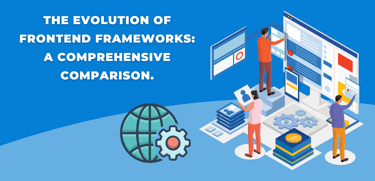
Frontend Frameworks Unveiled: A Comprehensive Comparison by AZ Konnect
By AZ Konnect Team
1/9/20242 min read


Introduction: The landscape of web development has witnessed a transformative evolution, especially in frontend frameworks, laying the foundation for enhanced user experiences and robust web applications. At AZ Konnect, we understand the significance of selecting the right frontend framework for a seamless and efficient development process. In this blog, we'll conduct a comprehensive comparison of various popular frontend frameworks, shedding light on their evolution, features, and suitability for different project requirements.
Evolution of Frontend Frameworks Explore the historical evolution of frontend frameworks, from early JavaScript libraries to modern, component-based frameworks. Discuss the catalysts behind their evolution and the need for more sophisticated frameworks.
Angular: Power and Versatility Delve into Angular's evolution, emphasizing its architecture, two-way data binding, TypeScript integration, and its application in building large-scale, feature-rich applications.
React: Flexibility and Reusability Discuss React's journey, highlighting its virtual DOM, component-based architecture, and the benefits of its unidirectional data flow. Explore how React has become a dominant choice for scalable and reusable UI components.
Vue.js: Simplicity and Progressive Enhancement Explore Vue.js' growth and its emphasis on simplicity, reactivity, and ease of integration. Discuss its gradual adoption and how it combines the best features of Angular and React.
Comparative Analysis: Performance and Scalability Conduct a comparative analysis of frontend frameworks, considering factors such as performance benchmarks, scalability, learning curves, community support, and ecosystem maturity.
Tooling and Ecosystem Support Discuss the tooling and ecosystem support provided by each framework, including developer tools, third-party libraries, state management solutions, and community-driven resources.
Adoption in Industry and Popular Use Cases Highlight real-world examples of each framework's adoption in industry sectors, showcasing their application in various use cases such as e-commerce platforms, single-page applications (SPAs), and enterprise solutions.
Learning Curve and Developer Experience Evaluate the learning curve and developer experience for each framework, considering documentation quality, ease of onboarding, and resources available for continuous learning and improvement.
Considerations for Framework Selection Provide guidance on selecting the most suitable framework based on project requirements, team expertise, scalability needs, performance goals, and long-term maintenance considerations.
Conclusion: Frontend frameworks play a pivotal role in shaping modern web development practices. At AZ Konnect, we recognize the importance of making informed decisions when choosing the right framework. This comprehensive comparison aims to equip developers and businesses with the insights needed to evaluate, choose, and leverage frontend frameworks effectively, ensuring the successful execution of their digital projects.
Subscribe To Our Newsletter


